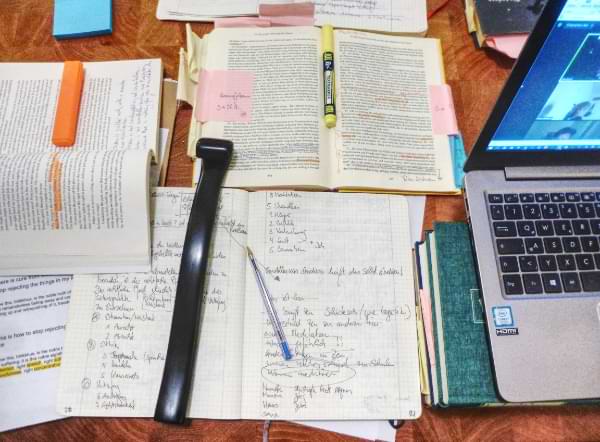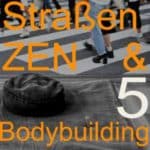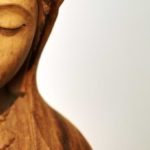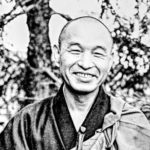Dharma Blog

Zen in Wort und Bild
Zen sei eine Erfahrung jenseits von Worten oder Bildern, heißt es. Und doch schreibt Jikishin Sensei auf dem Dharma Blog im Kanzeon Magazin über die Lehre des Buddha – das Dharma – und dessen Erscheinung und Manifestation in unserem westlichen Leben.
Was sich überhaupt sagen läßt, läßt sich klar sagen. Über den Rest schweigen wir.
Dharma Blog neueste Beiträge
Kategorie

Straßen, Zen und Bodybuilding 5
Darum bin ich heute morgen auf mein Kissen geschlichen, auch wenn ich Schmerzen habe und häufig verzage: ich will tun, was Buddhas tun: Sitzen und in mich hineinleuchten.

Zum Gedenken an Martha Ekyo Maezumi
Ekyo-San Maezumi starb friedlich am Sonntag, den 10. April 2022, in ihrem Haus in Kalifornien. Ekyo war die Ehefrau unseres verstorbenen geschätzten Lehrers und Gründers der White Plum Zenlinie, Taizan Maezumi Roshi. Sie waren seit 1975 verheiratet und haben drei Kinder: Kyrie, Yoshi und Yuri, und ein Enkelkind.

Straßen, Zen und Bodybuilding 4
Das erste Morgenzazen hat gerade begonnen und schon haben wir Hunger – Hunger nach der Haltung. Jetzt, um kurz nach sechs, schmecke ich Buddhas Haltung. Seit zweieinhalbtausend Jahren ist diese Haltung überliefert…

Was ist Kanzeon?
Kanzeon ist im Buddhismus der Name für die Verkörperung von Mitgefühl. Kanzeon ist Mitgefühl und gehört zur Familie der Bodhisattvas. Doch was ist ein Bodhisattva?
„Sie saß oben auf einem Schrank. Ich legte meine Hände wie Scheuklappen an die Scheibe, um in der Dunkelheit besser in den Verkaufsraum zu sehen. Ein Laden für Räucherwerk, Asiatika und feine Tücher in der Düsseldorfer Altstadt.“

Schätzen Sie Ihr Leben…
Der Ehrwürdige Hakuyu Taizan Maezumi Roshi, der maßgeblichen Einfluss auf das Wachstum des Zen-Buddhismus in den Vereinigten Staaten hatte, wurde im Alter von elf Jahren zum Soto-Zen-Mönch ordiniert. Er erhielt Abschlüsse in orientalischer Literatur und Philosophie an der Komazawa-Universität und studierte in Sojiji, einem der beiden wichtigsten Soto-Klöster in Japan.

Straßen, Zen und Bodybuilding 3
Das erste Morgenzazen hat gerade begonnen und ich erinnere mich: bisher haben wir das Zendo betreten, vor sechs Uhr morgens; wir haben uns auf unserem Kissen eingerichtet, der Roshi hat uns mit Kentan begrüßt und nun haben die ersten 40 Minuten Zazen angefangen…

Geführte Meditation 18-März-2020
Am 18. März 2020 – im Zuge der Corona-Krise – verlegte Kanzeon Sangha die physische Meditation vom Zen Zentrum Düsseldorf ins Internet. Diese Meditation „online“ war für Kanzeon Sangha eine Premiere. Teilnehmer baten Jikishin Sensei, auch eine geführte Meditation einzubauen. Diese Audiodatei ist eine bearbeitete Fassung der geführten Meditation vom Mittwoch.
Traditionslinie im Westen – Europa
Seit 1967 hat Zen auch in Europa Wurzeln getrieben. Die Soto-Schule hat die wichtigsten europäischen Tempel in einem kurzen Video portraitiert.

Die 7 Etappen des Zen-Weges
Hinterm Ofen stecken wir Glücklichen, behaglich und vornehm. In unserem Glück kommt dieser Gedanke auf: „Hoffentlich bleibt es immer so gemütlich!“ Wir Glücklichen rutschen auf unserem Kissen hin und her. Obwohl wir mit solchem Glück gesegnet sind, kommen Fragen in uns auf…
Traditionslinie im Westen – USA
Im letzten Jahrhunderts wurden die Samen gelegt für Zen im Westen. Die Soto-Schule hat die Ereignisse in einem Video portraitiert. Taizan Maezumi Roshi, einer dieser Protagonisten, ist der „Großvater“ unserer Zen-Linie in Deutschland.

Die 10 Leiden des Siddhartha
Jikishin Sensei folgt Siddharta auf dessen Weg zur Befreiung vom Leiden. Wir treffen die Dämonen des späteren Buddha – und das Leid, das er verursacht hat.

Straßen, Zen und Bodybuilding 2
1998 habe ich einige Erlebnisse meiner ersten zehn Jahre Zenpraxis aufgeschrieben. Ich habe mir damals die Ereignisse eines Morgensitzens während eines Sesshins vorgestellt und davon erzählt. Bisher haben wir das Zendo betreten, vor sechs Uhr morgens; wir haben uns auf unserem Kissen eingerichtet und nun warten wir auf den Beginn des Zazen…

Erleuchtung
Eine Flamme, sobald sie entzündet ist, erhellt ein Zimmer, das vorher dunkel war. Nun, da ich etwas sehen kann, kann ich mich zurechtfinden in dem Zimmer. Ich kann mich bewegen, ohne ständig an Tische oder Bänke zu stoßen. Sobald ich mich orientiert habe, kann ich anfangen, die Dinge, die im Zimmer sind, kennenzulernen und dann nach Belieben zu benutzen. War ich vorher blind, bin ich nun sehend…

Straßen, Zen und Bodybuilding 1
1998 habe ich einige Erlebnisse meiner ersten zehn Jahre Zenpraxis aufgeschrieben. Ich habe mir damals die Ereignisse eines Morgensitzens während eines Sesshins vorgestellt und davon erzählt. Wenn Sie wollen, folgen Sie mir, dem Erzähler, in den Meditationsraum: Wir betreten gemeinsam das Zendo, suchen unseren Platz und setzen uns auf das Meditationskissen…

Sitzen
Um Zen zu verstehen und sich in Zen wohlzufühlen, ist es gut, jeden Tag in Zazen zu sitzen. Um Zazen zu sitzen, wähle einen Ort, den Du magst und an dem Du länger als 20 Minuten ungestört bleiben kannst. Sorge dafür, dass die Temperatur und das Licht angenehm sind. Verschwende keine Zeit für die Suche oder Einrichtung des Ortes: Sitzen kannst Du überall.

Was ist Dharma?
Die Begriffe „Dharma” und „Budda-Dharma” tauchen auf dieser Webseite oft auf. Jikishin Sensei erklärt, wie er die historische Entwicklung der Begriffe versteht.

Jenseits von Zen und Nicht-Zen
Warmer Sand unter den Fußsohlen. Eine grüne Scherbe schneidet ins Blut. Der Schrei ist nur kurz. Kein Pflaster dabei.

Was ist nicht Zen?
Nicht-Zen ist alles, was scheinbar nicht Zen ist: Ego, Leiden, Alter, Krankheit, Tod, Ignoranz und Verwirrung… Um Nicht-Zen – Leiden – zu überwinden haben viele Menschen angefangen, Zen zu üben. Die Welle stemmt sich gegen den Ozean. Wenn wir nicht in Zazen sitzen: sind wir dann Nicht-Zen?

Was ist Zen?
Zen ist, „sich selbst“ zu sein. Zen ist ein Zweig der buddhistischen Lehre, die zum Ziel hat, das Leiden zu verringern oder ganz zu beenden. Zen ausüben bedeutet, sich Zazen anzuvertrauen.